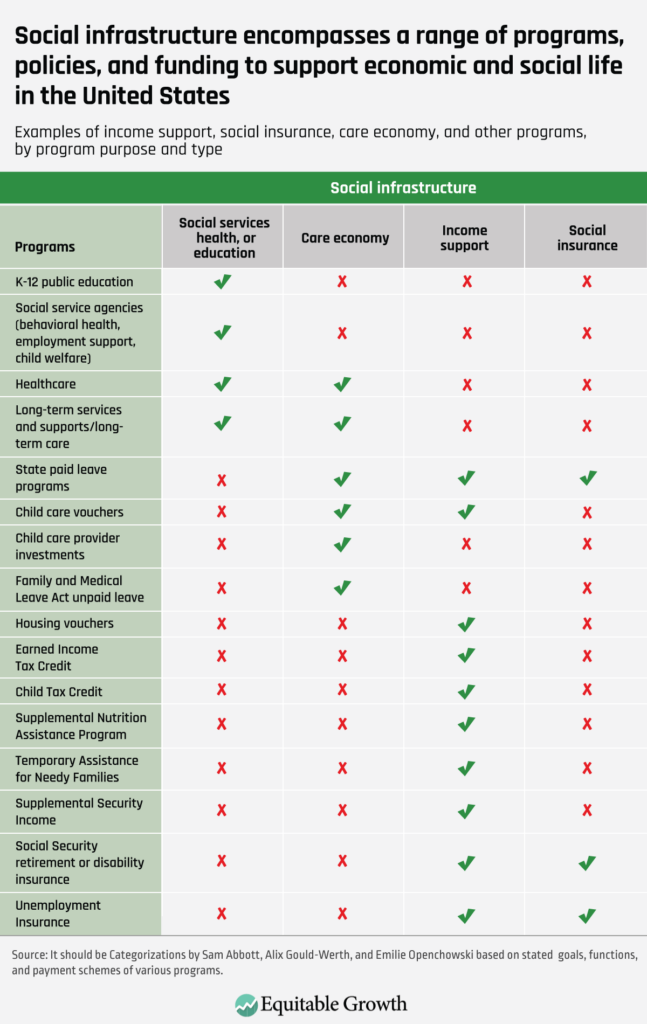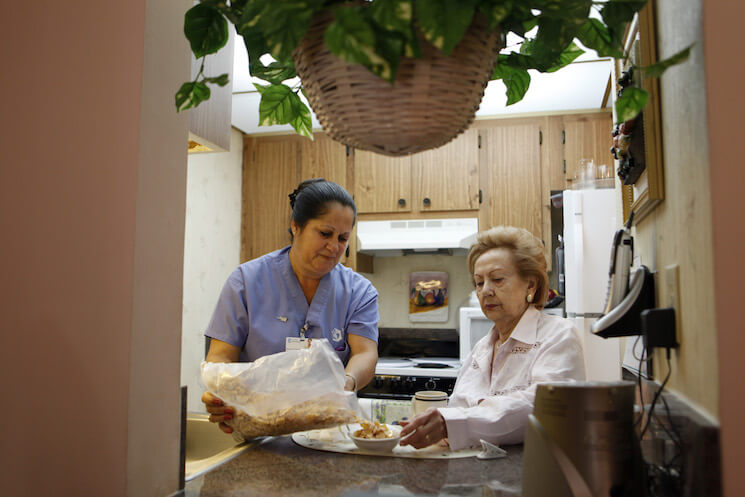What is social infrastructure, and how does it support economic growth in the United States?

The word “infrastructure” brings to mind the big physical systems that underpin the U.S. economy, such as highways, bridges, tunnels, and water and sewage systems. Indeed, infrastructure is composed of the very basic organizing structures that the economy and our society need to function. Without such necessities as electricity, for instance, daily life and economy activity would quickly grind to a halt.
Yet physical infrastructure isn’t the only type of infrastructure the U.S. economy and society needs in order to keep running. A less visible but equally important type of infrastructure is the social infrastructure that provides a foundation for other economic activity and helps maintain standards of well-being. Social infrastructure is the policies, resources, and services that ensure people can participate in productive social and economic activities. This includes social services, public education, and healthcare.
Two other fundamental components of social infrastructure are adequate care and adequate income. Ensuring that individuals and their families have the care they need—whether to address their own or a loved one’s medical issues or child care—allows people to meet their personal needs and participate in broader societal and economic activity. Similarly, having sufficient income to put food on the table and keep a roof overhead is a necessary precondition for maintaining a minimum standard of living and an ability to participate fully and productively in the economy.
Electricity, running water, transportation, and internet connectivity facilitate modern U.S. workers’ ability to get to their jobs and do them well. In the same vein, social infrastructure is essential to ensuring economic well-being for individuals and for society as a whole.
Conversely, the inadequate provision of social infrastructure can be a barrier to economic and social activity. When people have to scramble to arrange care for a child, an elderly parent, or a disabled family member; when they lack the health supports they themselves need; or when they are hungry, cold, or unhoused, they are hard-pressed to attend school, go to work, or otherwise participate in civil society.
Several policies develop and support social infrastructure in the United States. Investments in the care economy, also known as care infrastructure, are crucial to ensuring that people have access to the caregiving supports they need. These types of policies include government investments in healthcare, child care, and long-term services and supports for older adults and people with disabilities, as well as paid sick leave laws and paid family and medical leave programs.
Policies that ensure people have the income they need to be productive members of society and the economy are known as income support programs. Any program that transfers cash to an individual is an income support. Examples include the Earned Income Tax Credit, retirement Social Security, and state paid leave programs.
Additionally, in-kind transfers that cover needs that are so basic that mostly everyone spends on them—such as food and housing—are also considered income supports. By receiving income to cover these basic needs, people can free up money in their budgets for other things. For this reason, programs such as the Supplemental Nutrition Assistance Program, child care subsidies, and subsidized housing are often considered income support programs.
Some policy analysts further divide income support programs into social insurance programs and other income transfer programs that are variously referred to as social welfare, social assistance, public assistance, or means-tested programs. Social insurance is a type of income support program that has a very specific structure, in which an individual pays an earmarked tax into a specific fund that only covers that income support program, such as Unemployment Insurance, disability or old-age Social Security, or a state paid family leave program. Then, if individuals become eligible for these programs—because they lose their jobs, become disabled, age, or have a child, for example—they are paid money out of that specific fund.
Other income support programs have different revenue structures and are thus not generally considered social insurance. These programs include the Supplemental Nutrition Assistance Program, Temporary Assistance for Needy Families, and Supplemental Security Income—all of which provide income support for people but are not funded by contributions from those individuals. Rather, they are funded by general tax revenue and may include some cost-sharing by states. (See Table 1.)
Table 1

Often, academics, policymakers, journalists, and the general public use the misplaced metaphor of the “social safety net” when referring to investments in social programs in the United States. Of course, some programs are indeed there to “catch” people who experience a temporary “fall,” such as a job loss or sudden onset of a health problem. But this metaphor doesn’t work well for the many social programs that are necessary to support daily life unfolding in a predictable manner, free of catastrophe.
Just as electric lighting is not a safety net catching a person who faces darkness each night, routinely provided preventative healthcare is not a safety net catching someone who faces the challenges of maintaining a healthy body each day. Similarly, having a child is a normal life event that must be supported over the full course of the child’s development, so that future generations can be productive in our economy and engaged in our society. Social infrastructure is the necessary foundation of daily life and its accompanying economic rhythms, not simply a temporary Band-Aid in a moment of emergency.
Sometimes, policymakers and advocates justify investments in social programs using the language of moral imperatives or kindness toward those in our communities who are suffering. These are fair motivations to invest in many social programs. But they are not the only reasons. All people in society need social infrastructure. As detailed above, it takes sustained investment in physical and social infrastructure to undergird an economy and a society in which people have adequate living standards throughout their lives and are productive members of the U.S. workforce.
The importance of physical infrastructure to the U.S. economy and society is broadly understood and garners wide bipartisan support. Research shows that sustained government investment in social infrastructure also fosters economic growth by facilitating labor force participation, developing the human capital of the next generation of workers, allowing the current generation of workers to deploy the capital they’ve already developed, and stabilizing the macroeconomy. Understanding the abiding importance of social infrastructure highlights exactly why social infrastructure policy and investments benefit us all—now and in the future.






